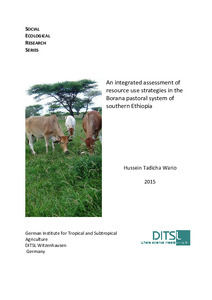| dc.date.accessioned | 2015-08-18T11:40:28Z | |
| dc.date.available | 2015-08-18T11:40:28Z | |
| dc.date.issued | 2015-08-18 | |
| dc.identifier.isbn | 978-3-945266-01-4 | |
| dc.identifier.uri | urn:nbn:de:hebis:34-2015081848958 | |
| dc.identifier.uri | http://hdl.handle.net/123456789/2015081848958 | |
| dc.description.sponsorship | With the financial support of the Federal Ministry for Economic Cooperation and Development, Germany | eng |
| dc.language.iso | eng | |
| dc.rights | Urheberrechtlich geschützt | |
| dc.rights.uri | https://rightsstatements.org/page/InC/1.0/ | |
| dc.subject | Pastoral resource use | eng |
| dc.subject | Pastoral land use | eng |
| dc.subject | Southern Ethiopia | eng |
| dc.subject | Borana | eng |
| dc.subject | Livestock mobility | eng |
| dc.subject.ddc | 630 | |
| dc.title | An integrated assessment of resource use strategies in the Borana pastoral system of southern Ethiopia | eng |
| dc.type | Dissertation | |
| dcterms.abstract | In the pastoral production systems, mobility remains the main technique used to meet livestock’s fodder requirements. Currently, with growing challenges on the pastoral production systems, there is urgent need for an in-depth understanding of how pastoralists continue to manage their grazing resources and how they determine their mobility strategies. This study examined the Borana pastoralists’ regulation of access to grazing resources, mobility practices and cattle reproductive performances in three pastoral zones of Borana region of southern Ethiopia. The central objective of the study was to contribute to the understanding of pastoral land use strategies at a scale relevant to their management. The study applied a multi-scalar methodological approach that allowed zooming in from communal to individual herd level. Through participatory mapping that applied Google Earth image print out as visual aid, the study revealed that the Borana pastoralists conceptualized their grazing areas as distinctive grazing units with names, borders, and specific characteristics. This knowledge enables the herders to communicate the condition of grazing resources among themselves in a precise way which is important in management of livestock mobility. Analysis of grazing area use from the participatory maps showed that the Borana pastoralists apportion their grazing areas into categories that are accessed at different times of the year (temporal use areas). This re-organization is an attempt by the community to cope with the prevailing constraints which results in fodder shortages especially during the dry periods. The re-organization represents a shift in resource use system, as the previous mobility practice across the ecologically varied zones of the rangelands became severely restricted. Grazing itineraries of 91 cattle herds for over 16 months obtained using the seasonal calendar interviews indicated that in the areas with the severest mobility constraints, the herders spent most of their time in the year round use areas that are within close proximity to the settlements. A significant change in mobility strategy was the disallowing of foora practice by the communities in Dirre and Malbe zones in order to reduce competition. With the reduction in mobility practices, there is a general decline in cattle reproductive parameters with the areas experiencing the severest constraints showing the least favourable reproductive performances. The study concludes that the multi-scalar methodology was well suited to zoom into pastoral grazing management practices from communal to individual herd levels. Also the loss of mobility in the Borana pastoral system affects fulfilment of livestock feed requirements thus resulting in reduced reproductive performances and herd growth potentials. While reversal of the conditions of the situations in the Borana rangelands is practically unfeasible, the findings from this research underscore the need to protect the remaining pastoral lands since the pastoral production system remains the most important livelihood option for the majority of the Borana people. In this regards the study emphasises the need to adopt and domesticate regional and international policy frameworks such as that proposed by the African Union in 2010. | eng |
| dcterms.accessRights | open access | |
| dcterms.creator | Wario, Hussein Tadicha | |
| dcterms.isPartOf | Social Ecological Research Series ;; 1 | eng |
| dc.contributor.corporatename | Kassel, Universität Kassel, Fachbereich Ökologische Agrarwissenschaften | |
| dc.contributor.referee | Hensel, Oliver (Prof. Dr.) | |
| dc.subject.swd | Äthiopien | ger |
| dc.subject.swd | Borana | ger |
| dc.subject.swd | Bodennutzung | ger |
| dc.subject.swd | Viehwirtschaft | ger |
| dc.subject.swd | Weidewirtschaft | ger |
| dcterms.source.series | Social Ecological Research Series | |
| dcterms.source.volume | 1 | |
| dc.date.examination | 2015-07-30 | |

